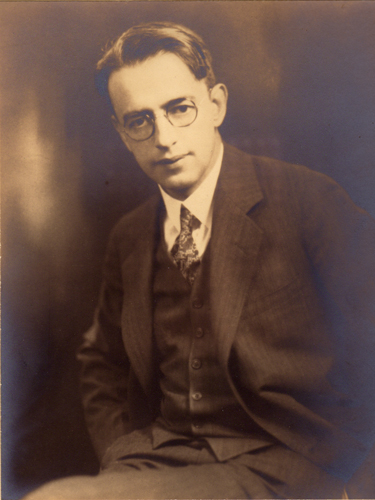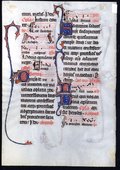Otto F. Ege Collection
The Ege Manuscript Leaf Portfolios

In the late 1940s, longtime Cleveland resident and art historian Otto F. Ege selected fifty medieval manuscripts from his personal collection and removed several dozen individual pages from each one. He mounted each leaf onto a large paper mat using tape hinges, and added a descriptive label to the mat. He then put one leaf from each of the fifty component manuscripts into a durable portfolio box; each of the resulting boxed sets thus contained a different leaf from each of the fifty original manuscripts. Forty boxes containing fifty leaves each were made in this way, and were offered for sale to university and public libraries around North America.
This was an extraordinary thing to do. For centuries, the act of biblioclasty (literally, "book-breaking") has been reviled--in most people's minds there exists an urge to protect books, especially old ones, and to view cutting pieces out of them as nearly acute a crime as burning them outright. But Ege's impulse was actually a largely altruistic one. He had devoted his career to teaching book arts such as decoration, typography, and layout design to the general public, and he believed that the transformative beauty of medieval book decoration could inspire bookmakers today to greater heights of creativity. He authored dozens of articles on this subject in art education journals, and loaned materials to public book exhibits regularly. His "Fifty Original Leaves from Medieval Manuscripts" portfolios were part of his longstanding commitment to populist art education in North America.
The manuscripts he took apart were his personal property, and there is strong evidence that most if not all of the books he used in this project were already damaged in some way. Manuscripts which have lost their front or back covers, or from which pages are already drifting out, were (then as now) less expensive to acquire than ones with intact bindings. They were mostly books that saw a lot of use during church services in the Middle Ages: Bibles, psalters (collections of the Psalms), missals (books containing the text of the mass), hymnals, Books of Hours (personal prayer books, often owned by wealthy women), breviaries (prayer books used by priests), and so on. Rarer items in the portfolios include pages from 15th-century manuscripts of Livy's History of Rome, Thomas Aquinas's Commentary on the Sentences of Peter Lombard, and the Dialogues of Gregory the Great. The relative scarcity of copies of these latter texts, combined with the high quality of the work of their scribes, earns these three leaves special mention.

A secondary intention of Otto Ege's in making these sets was, of course, to profit financially from what was by then more than thirty years of book collecting. Sadly, Ege died in 1951 before selling any of these particular manuscript portfolios. His widow Louise, however, continued with the commercial plan, and began selling the boxed sets compiled by her husband to individuals and institutions for $750 each. Denison University is fortunate to own one of these forty portfolios, purchased in 1956 by Denison alumnus, benefactor, and longtime trustee Percy Wiltsee (Class of 1901), who then generously donated the set to the college.
To date, thirty of Ege's forty specimen sets of medieval manuscript leaves have been located, nearly all of them in libraries in the U.S. and Canada. The purpose of this website is to provide a single location where images, descriptions, and other information about Otto Ege and his leaves can be gathered and shared; in a sense, it is an attempt to "virtually" reconstruct the component manuscripts, as well as to promote the study of one of the most important figures of 20th-century book collecting. We hope you find the contents of this site useful, and invite your participation to the ongoing project of Ege Studies as we move into the future.
Greta Smith (Miami University) and Fred Porcheddu (Denison University)
May 2008